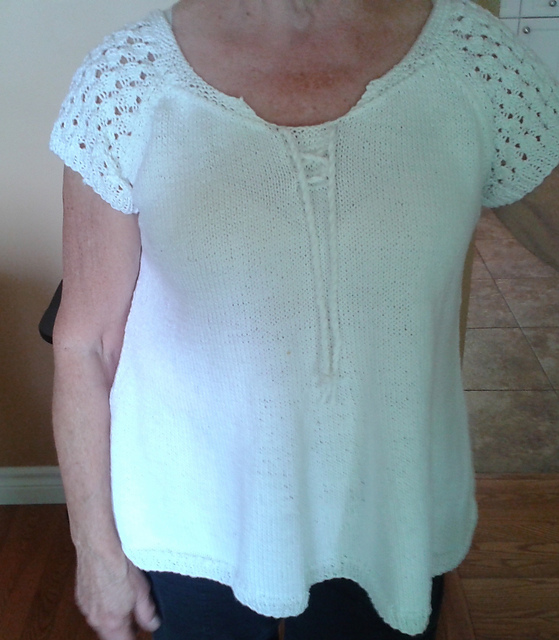Trying to help knitters knit sweaters that fit is all for nothing if gauge isn't part of the calculation. Gauge is something the knitter has to
'get'. Both on the needles and in the head. And there are so many knitters who do not
get gauge. Oh the stories I could tell.
Like Knitter A, who asked a fellow knitter what size she knit because Knitter A wanted her sweaters to fit just as nicely. As if the size chosen was the only factor involved in the fit.
Or like the knitter who said she was searching for cotton yarn because her pattern called for cotton. As if that was more important than the gauge recommended.
Gauge is all important. Knowing how many inches around you want your sweater to be is a start. But you can only be sure that your knitting will give you the correct number of inches IF you knit to the same gauge as the pattern gauge.
Think of gauge - stitches to the inch - as the number of apples in a box. The smaller the apples the more it takes to fill the box. Conversely, the bigger the apples the fewer it takes to fill the box. Apples in a box - stitches in an inch. The smaller the stitches, the more you have in every inch.
So how does this affect fit? Well - you know how many inches around you want your sweater to be to fit you nicely because you measured a sweater that fits you nicely. But you will only achieve that number of inches if your knitting gauge matches the pattern gauge. If the pattern calls for 5 stitches to the inch, but you are knitting 4 or 6 or 3.5 or 8 or anything but 5 stitches to the inch, your knitting will not end up measuring the same as the pattern.
To know if you are knitting the same number of stitches to the inch as the pattern recommends, you must
DO A GAUGE SWATCH. And the swatch must be large enough to be read-able - accurately read-able. Not like the knitter with a pattern that called for 11 stitches over two inches, so she cast on 11 stitches and knit two rows. Really? Do two rows of knitting in any way provide a good test for a sweater? Are the same influences at play over 11 stitches as over an entire front or back of stitches? Of course not..
So here's my recommendation for a good gauge swatch.
Yarn and Needles: Same as you intend to use for the sweater.
How Many Stitches?? Ten stitches more than the pattern gauge calls for. If the pattern calls for 20 sts/4 inches, cast on 30 stitches.
How many rows?? Knit garter stitch for 4 rows. Knit stockinet stitch for 40 rows, keeping the first and last three stitches of each row in garter stitch. Finish the piece with 4 rows of garter. What you have created is a piece of knitting which will lie flat because of the garter stitch edges. A nice flat piece of knitting allows for a nice accurate measurement to be taken.
Treatment: Before measuring, wash the piece as the ball band on the yarn recommends. Leave to dry.
Measuring: One or two stitches into the stockinet section from the left garter stitch edge, place a straight pin alongside a stitch. From that pin, measure four inches across the piece and insert another pin. Count the stitches between the two pins.
Winner, Winner, Chicken Dinner??? If your stitch count, pin to pin, across four inches is the same as the pattern recommends - YIPPEE! Start knitting your sweater.
If not, you will have to repeat the gauge swatch with a different needle size. But how do you know whether to go up or down in needle size? Well, back to our box of apples. If there are fewer than 20 apples in our four inch 'box' that means the apples are too big to fit 20 of them into that box. We need smaller
apples stitches. To get smaller stitches, use a smaller needle. Perhaps the opposite is the case and there are more than 20 apples in the box. That means the apples are too small. You need bigger
apples stitches. To get bigger stitches, use bigger needles.
All this info from the last few days, comes with a guarantee. If you follow the measuring instructions, the tweaking instructions for waist, bust, belly and back variations, and the gauge instructions and
still your sweater does not fit, here is my guarantee: Grab your sweater, your yarn and your needles, get on a plane, train or automobile and get yourself to my house. We'll spend a weekend re-doing your sweater so it's perfect. There will be refreshments and Fred will wait on us hand and foot so all we have to do is knit.



































